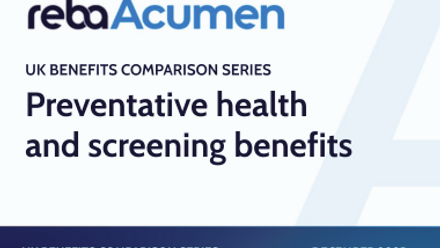6 ways to boost employee wellbeing through prevention
Here's an uncomfortable truth: your employees are probably waiting to get sick before they engage with health services. Annual health screenings sit unused, wellness programmes gather dust, and mental health resources remain untapped until crisis strikes.
In fact, over half (58%) of HR leaders openly admit that their health and wellness benefits are underutilised. Meanwhile, preventable health issues are quietly draining your productivity, inflating your healthcare costs, and burning out your workforce.
Research shows UK employees now take an average of 7.8 sick days annually costing businesses between £429-£702 per employee each year in absenteeism alone.
Yet despite 93% of organisations offering health benefits, only 57% of employees feel their employer proactively supports their wellbeing, revealing a significant disconnect between what's provided and what's perceived as valuable support.
The traditional approach to workplace health has been reactive - respond when problems arise, treat symptoms, and hope for the best. The challenge isn't convincing employees that health matters - it's showing them that prevention is worth their time, attention, and effort right now.
Here are six evidence-based strategies that HR leaders can implement through modern employee benefits platforms to drive real engagement with preventive health initiatives.
1. Create health moments that matter
Rather than scheduling annual health events that feel disconnected from daily work life, integrate health touchpoints into existing routines through accessible benefits. Transform mundane moments into opportunities for health awareness.
In practice:
- Use health cash plans to make routine health checks financially accessible and convenient
- Leverage gym discount programmes to encourage movement during lunch breaks or after work
- Build wellbeing check-ins into regular one-to-ones, supported by data from health screenings
2. Make data personally compelling
Generic health information doesn't drive behaviour change - personal insights do. The most engaging preventive health programmes give employees meaningful data about their own health risks and potential through targeted testing and screening services.
In practice:
- Offer access to services like YorkTest for at-home allergy testing to help employees understand how intolerances and sensitivities might be affecting their energy and performance
- Encourage employees to utilise health screenings to generate individualised reports that translate numbers into actionable insights
- Show employees exactly how their current habits impact their energy levels, sleep quality, and long-term health prospects
3. Address the barriers, not the symptoms
Low engagement with preventive health usually stems from practical obstacles rather than lack of interest. Successful programmes systematically remove these barriers through comprehensive benefits platforms that offer multiple access points and support systems.
In practice:
- Survey employees about what prevents them from engaging with health and wellness initiatives in the workplace
- Use services like Companiions to address work-life balance challenges that prevent health engagement
- Offer multiple ways to access the same service through retail discount platforms like BenefitHub, for spa days, gym equipment, and wellness activities
4. Connect health to performance
The most compelling preventive health programmes explicitly link wellbeing to work performance. When employees understand how their health directly impacts their ability to succeed professionally, engagement increases dramatically.
In practice:
- Use Cycle to Work salary sacrifice schemes to demonstrate how physical activity during commuting improves focus and energy
- Help employees see connections between better sleep and decision-making quality through health cash plan consultations
- Leverage gym discounts and fitness apps to show links between stress management and creativity or problem-solving
5. Build social momentum
Individual health decisions are heavily influenced by social context. Programmes that create positive encouragement and community support see significantly higher engagement than those targeting individuals in isolation.
In practice:
- Form cross-departmental cycling groups through cycle to work schemes that naturally create workplace wellness communities
- Use gym discount programmes to encourage group memberships and workout buddies
- Share success stories (with permission) from health screening results or allergy testing outcomes that colleagues can relate to
6. Measure what matters to employees
Most health programmes measure clinical outcomes or participation rates, but employees care about different metrics. Align your measurement approach with what actually motivates your workforce through comprehensive benefits tracking.
In practice:
- Track improvements in energy levels, sleep quality, stress management, and work-life balance alongside traditional health metrics
- Use regular pulse surveys to reveal which aspects of your benefits platform employees find most valuable
- Monitor engagement across different benefit categories - from health cash plans to gym discounts to holiday trading - to understand what drives participation
The prevention advantage through comprehensive benefits
Organisations that successfully engage employees with preventive health through comprehensive benefits platforms create a powerful competitive advantage.
They're not just reducing healthcare costs - they're building more resilient, energised, and productive teams. These employees take fewer sick days, report higher job satisfaction, and demonstrate greater loyalty to their employers.
When prevention becomes the norm rather than the exception - supported by accessible, varied, and engaging employee benefits - everyone wins. Preventing health issues before they start isn't just better for employees - it's transformational for business performance.
Supplied by REBA Associate Member, Avantus
Flexible Benefits & Technology specialist providing online, highly configurable platforms to Customers and Intermediaries worldwide.








